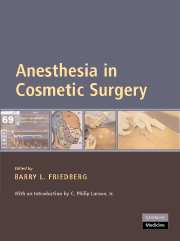Book contents
- Frontmatter
- Contents
- Foreword
- Acknowledgments
- Introduction
- Preface
- List of Contributors
- PART I MINIMALLY INVASIVE ANESTHESIA (MIA)Ⓡ FOR MINIMALLY INVASIVE SURGERY
- PART II ALTERNATIVE ANESTHESIA APPROACHES IN COSMETIC SURGERY
- PART III OTHER CONSIDERATIONS FOR ANESTHESIA IN COSMETIC SURGERY
- APPENDIX A A Guide to Perioperative Nutrition
- APPENDIX B Reflections on Thirty Years as an Expert Witness
- Index
Preface
Published online by Cambridge University Press: 22 August 2009
- Frontmatter
- Contents
- Foreword
- Acknowledgments
- Introduction
- Preface
- List of Contributors
- PART I MINIMALLY INVASIVE ANESTHESIA (MIA)Ⓡ FOR MINIMALLY INVASIVE SURGERY
- PART II ALTERNATIVE ANESTHESIA APPROACHES IN COSMETIC SURGERY
- PART III OTHER CONSIDERATIONS FOR ANESTHESIA IN COSMETIC SURGERY
- APPENDIX A A Guide to Perioperative Nutrition
- APPENDIX B Reflections on Thirty Years as an Expert Witness
- Index
Summary
The very essence of leadership is that you have a vision.
—Theodore HesburghCaesar's Gallic Wars begins with the observation that “All Gaul is divided into three parts.” Anesthesia in Cosmetic Surgery is also divided into three parts.
Part I, Chapters 1–10, is devoted to minimally invasive anesthesia (MIA)® for minimally invasive surgery. (The United States Patent and Trademark Office [USPTO] granted trademark serial number 76/619,460, file number 067202-0312946 to minimally invasive anesthesia [MIA] to Dr. Friedberg in 2005.)
Part I advances the premise of a unitary anesthetic technique for all elective cosmetic surgery. Part I challenges the belief that only some types of elective cosmetic surgery are suitable for intravenous sedation. Many readers may be similarly challenged by the description of abdominoplasty, an extraperitoneal procedure, as a minimally invasive surgery.
Inasmuch as the MIA™ technique is not universally applicable for every surgical personality, Part II, Chapters 11–13, is dedicated to providing a comprehensive view of other anesthetic techniques administered by dedicated anesthesia professionals. Deliberately omitted are those approaches of oral and intravenous sedation directed by the surgeon in the absence of a dedicated anesthesia provider.
There is much about the practice of anesthesia in cosmetic surgery that is not specifically related to anesthetic technique. Part III, Chapters 14–18, and Appendices A and B illustrate the chasm between the medically indicated (third-party reimbursed) anesthesia practice and that particular to anesthesia for elective cosmetic surgery.
- Type
- Chapter
- Information
- Anesthesia in Cosmetic Surgery , pp. xvii - xviiiPublisher: Cambridge University PressPrint publication year: 2007

